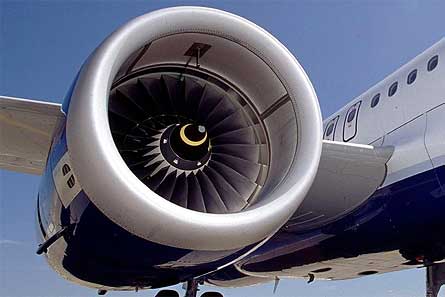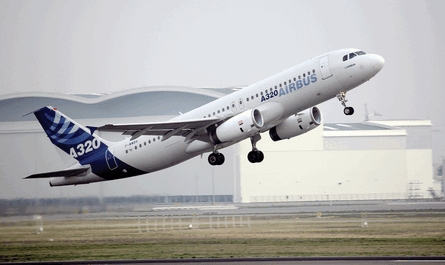International Aero Engines is entering the Paris air show upbeat despite the economic downturn.
The engine maker had a big 2008, securing record orders, certificating the SelectOne upgrade for the V2500 and celebrating its 25th anniversary. But president and chief executive Jon Beatty says that 2009 will be another big year for IAE.
"For us 2009 is a very special year. We will be delivering our 4,000th engine," Beatty says. "It's also our 20th year since the V2500 entered service. We'll also achieve 15 million hours of revenue service this year on the A5 model."
Beatty concedes that new orders this year will not match the over 600 it chalked up in 2007 and 2008. But with engine selections often lagging airframe orders by up to 18 months, IAE should enjoy a better 2009 than the airframe manufacturers. "I don't think we'll see another record year this year, but we'll be net positive," Beatty says.
 |
|---|
© IAE |
He adds: "We're seeing slowed growth but we're still seeing growth. We're still seeing growth in China. And we're still doing some new business in Europe."
IAE is particularly bullish on China, where Beatty says IAE is "doing real well" despite the stiff losses and traffic declines reported by most Chinese carriers over the past year. He says that while the downturn has prompted Chinese carriers to defer delivery of new widebodies, there have not yet been any cancellations or deferrals of Airbus A320s, which are powered by the V2500 and the rival CFM International CFM56.
While V2500s power roughly 50% of the A320s worldwide, Beatty says in recent years IAE has been selected for 72% of the A320s ordered by Chinese carriers. He points out that IAE was the first supplier to have employees onsite at the new Airbus A320 assembly plant in Tianjin and V2500s will power nine of the first 10 A320s to be delivered by the new facility.
IAE shipped the first V2500 to Tianjin in March. The first Chinese-assembled A320 flew for the first time in May and is scheduled for a June delivery to Sichuan Airlines. Sichuan is one of several Chinese carriers to have placed large new orders for V2500s over the past two years. Sichuan, China Eastern Airlines, China Southern Airlines, Hainan Airlines, Shenzhen Airlines and Shanghai Airlines combined now have outstanding orders for more than 120 V2500-powered A320s, according to Flight's ACAS database.
With a majority of the A320s assembled in China due to be powered by V2500s, Airbus Tianjin could easily account for 10% of IAE's total output. Airbus plans to initially assemble two aircraft a month in Tianjin, but production is expected to reach four A320s a month by 2011. Beatty says IAE plans to produce 330-340 V2500s this year, down slightly from the 360 produced last year to reflect Airbus's decision to cut A320 production from 36 to 34 aircraft a month.
"We will do between 330 and 340 in 2009 and something similar to that in 2010," Beatty says. "I haven't finalised my 2010 plan or production yet because I think there's some probability that Airbus may have a further rationalisation of production. But I don't think it will be a dramatic rate reduction."
 |
|---|
Half of the V2500s are produced at Pratt & Whitney in Connecticut and the other half at Rolls-Royce in Germany. P&W and R-R each have 32.5% stakes in IAE, while Japanese Aero Engines (JAEC) own 23% and Germany's MTU Aero Engines the remaining 12%.
IAE is also hoping its recent success in China will give it a leg up in the competition to select an engine for the country's new large commercial aircraft project. The Commercial Aircraft Corporation of China (Comac) last year unveiled plans to develop a new 130- to 200-seat aircraft aimed at replacing A320s and Boeing 737s from 2016. Beatty confirms IAE is one of several engine makers to have responded to a request for information from Comac.
"We are working with Comac," Beatty says. "We have dialogue. We have paper being exchanged back and forth with Comac."
The new Chinese project has its share of sceptics, but IAE is not one of them. "The Chinese will build a very successful aircraft," Beatty says. "It may be off schedule at the beginning, but eventually they will build a nice product."
While P&W's new GTF geared turbofan engine has been selected by Bombardier for the new 110- to 130-seat CSeries small airliner and by Mitsubishi Aircraft for the new 70- to 90-seat MRJ regional jet, Beatty says that for larger single-aisle aircraft a consortium approach is more likely. "I just came back from a board meeting in London and Rolls, Pratt, MTU and JAEC have all stated emphatically that IAE is the preferred route to market," he says. "We are the route to market for a single-aisle aircraft. The IAE franchise is wildly successful. The brand name is irreplaceable. Finally now we're getting almost as well known as CFM."
Beatty says P&W's launch of the GTF "doesn't scare me at all" and he is not concerned P&W will try to offer their own powerplant for any new narrowbody product launched by Airbus or Boeing. "What would scare me is if my shareholders weren't developing technology. What I have now is the best of all worlds," he says. "I got Pratt & Whitney developing geared turbofan technology. I got Rolls-Royce heavily investing in technology. MTU is starting to come into their own developing their own technology. The Japanese have always been a significant source of technology and revenue. And I sit here today and there's no defined aircraft yet."
He says "picking the configuration now for the next-generation single-aisle would be premature", but adds that "there's no doubt in my mind that if either Boeing or Airbus was to launch that we could put a product together. In fact we have submitted proposals to several airframers on brand-new engines on what we could do."
Beatty says IAE also has its own technology people working on further improvements to the V2500 beyond the Select1 upgrade, which entered service last October with 1% improved fuel burn and 20% improved time on wing. IAE claims the upgrade increases the V2500's fuel burn advantage over the CFM56 from 3% to 4%. CFM earlier this year unveiled its own upgrade that will improve fuel burn by 1% from 2010, but Beatty points out that the V2500's fuel burn advantage will only be reduced back to 3% "if we don't do anything".
"We continue to develop product improvements ourselves," he adds. "We clearly aren't sitting still. We have other advances we are working on."
Source: Flight Daily News























